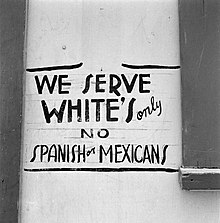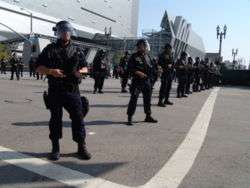Hispanophobia
Hispanophobia (from Latin Hispanus, "Spanish" and Greek φοβία (phobia), "fear") (or Anti-Spanish sentiment) is a fear, distrust of, aversion to, hatred of, or discrimination against the Spanish language, Hispanic people, and/or Hispanic culture. This historical phenomenon has had three main stages, originating in 16th-century Europe, reawakening during 19th-century disputes over Spanish and Mexican territory such as the Spanish–American and Mexican–American Wars, and finally in tandem with politically charged controversies such as bilingual education and illegal immigration to the United States. Within the complex of identity politics in Spain, Catalan, Basque, and Galician nationalism has also been identified with hispanophobic views and discourse.
History
The Black Legend
Early instances of Hispanophobia arose as the influence of the Spanish Empire and the Inquisition spread through late-medieval Europe. During this period Hispanophobia materialized in folklore which is sometimes referred to as the Black Legend:
The legend first arose amid the religious strife and imperial rivalries of 16th-century Europe. Northern Europeans, who loathed Catholic Spain and envied its American empire, published books and gory engravings which depicted Spanish colonization as uniquely barbarous: an orgy of greed, slaughter and papist depravity, the Inquisition writ large.[1]
La leyenda negra, as Spanish historians first named it, entailed a view of Spaniards as "unusually cruel, avaricious, treacherous, fanatical, superstitious, hot-blooded, corrupt, decadent, indolent, and authoritarian". As Spain and England colonized the Americas, "[t]he Black Legend informed Anglo Americans' judgments about the political, economic, religious, and social forces that had shaped the Spanish provinces from Florida to California, as well as throughout the hemisphere".[2] These judgments were handed down from Europeans who saw the Spaniards as inferior to other European cultures.[3]
Thus in North America, Hispanophobia preceded the United States' Declaration of Independence by almost two hundred years. Historians theorize that the English and the Dutch employed and encouraged it as part of their efforts to undermine the Spanish Empire; early New Englanders engaged in Hispanophobic efforts to assimilate Spanish colonies:
[I]n North America a deep current of Hispanophobia pervades Anglo-Saxon culture. ... As early as the late seventeenth century, we find Puritan divines like Cotton Mather and Samuel Sewell studying Spanish—with a view to winning converts to their version of Protestantism. Sewell spoke of "bombing [sic] Santo Domingo, Havana, Puerto Rico, and Mexico itself" with the Spanish Bible, and Cotton Mather even wrote a book on Protestant doctrine in Spanish, published in Boston in 1699, intended for—as he might say—the darker regions of Spanish America.[4]
In the United States

In the United States during the early 20th century, Anglo-Americans used eugenics as a basis for their hispanophobia. With support from the eugenicist, C.M. Goethe, hispanophobia became a political issue.[5] "Another circumstance," according to historian David J. Weber, "that shaped the depth of Anglo Americans' hispanophobia was the degree to which they saw Hispanics as an obstacle to their ambitions".[2] As the U.S. grew into a republic, anti-Spanish sentiment exhibited a recrudescence. Spain was perceived as both the antithesis of the separation of church and state and a paragon of monarchy and colonialism; this apparently fundamental opposition to the United States' founding principles fueled hostility that would eventually culminate in the Spanish–American War of 1898.[4] Hispanophobia is particularly evident in the historiography of the Texas Revolution:
In essence, the Texas rebellion had been little more than a struggle for political and economic power, but early Texas historians elevated the revolt against Mexico to a 'sublime collision of moral influences', a 'moral struggle,' and 'a war for principles'. ... Hispanophobia, with its particularly vitriolic anti-Mexican variant, also served as a convenient rationale to keep Mexicans 'in their place.'[2]
Throughout the 20th century, an array of mostly political and economic forces drove immigration from a multitude of Spanish-speaking countries—such as Cuba, Guatemala, the Dominican Republic, and Mexico—to the relatively strong economy and stable political environment of the United States. As a result, according to some historians, Americans "now have something called a 'Hispanic,' which describes not someone born in a Spanish-speaking country, nor someone who speaks Spanish well or badly, nor even someone with a Hispanic surname, but someone who identifies himself as such".[4] As a key corollary to this development, it is toward this group, which is not precisely or rigorously defined, that U.S. hispanophobia is now predominantly oriented. Many forms of hispanophobia endemic to the Texas Revolution still flourish in the United States today.[2]
Contemporary forms of hispanophobia in the United States
"Official English"
Sociologists cite the "Official English" or English-only movement, together with hispanophobic jokes and discourse, as a prominent example of modern-day hispanophobia.[6] The "Official English movement" has been criticized because its mass appeal is not as relating to any measurable benefit that would result from the eradication of bilingual education and other bilingual services. Rather, its appeal results from the fact that "challenges to the status of one's language typically engage deep-seated feelings about national identity and group worth".[7] Proponents of this view point out that the English-only movement attracts public support primarily by functioning as a hispanophobic form of intimidation.
Immigration controversy
Citing groups such as the Minuteman Project, sociologists have concluded that some anti-illegal-immigration arguments in the United States have been tainted with xenophobia and hispanophobia, many of them drawing on concepts of racial purity and eugenics. These groups' concern with illegal immigration, they assert, "lies not in immigration per se., which has declined in the last decade, but in the changing national origin of new immigrants, that is immigrants are now mainly Latin American or Asian, which is seen as a threat to the Anglo-Saxon tradition".[8]
In 2006, Arizona Attorney General Terry Goddard and U.S. Attorney Paul Charlton sent a letter of complaint to Federal Communications Commission chairman Kevin Martin, in response to the following comments made by radio host Brian James:
We'll call it 'Immigration Roulette,' What we'll do is randomly pick one night every week where we will kill whoever crosses the border. Step over there and you die. You get to decide whether it's your lucky night or not. I think that would be more fun.[9]
Calling the speech "dangerous and totally irresponsible for anyone, particularly a licensed body using public airways", Goddard and Charlton expressed concern that it would lead to violence in the state, where conflict over illegal immigration was growing increasingly heated.[10] The radio host said the remarks were "satirical"; the radio station, KFYI, indicated that James was trying out for a regular position on the station and was not an employee.[11]
New Jersey internet radio host, white supremacist, and convicted felon Hal Turner who used to broadcast out of his house made similar remarks, a number of which the Anti-Defamation League has posted under the category of extremism. On April 1, 2006, Turner said:
These filthy, disease ridden, two-legged bags of human debris are too stupid to believe....Just think, America, if we bring enough of them here, they can do for America exactly what they did for Mexico! Turn our whole country into a crime-ridden, drug infested slum....These people are sub-human. I would love it if folks who do have such weapons, used them on the crowds on April 10 [at immigration rallies]. I advocate machine gunning these invaders to death at their rallies![12]
See also
- Category:Racially motivated violence against Hispanic and Latino Americans
- Anti-Catholicism
- Anti-Mexican sentiment
- Latin American diaspora
- Latin America–United States relations
- Migration from Latin America to Europe
- Stereotypes of Hispanic and Latino Americans in the United States
Notes
- Horwitz, Tony (9 July 2006). "Immigration — and the Curse of the Black Legend". New York Times. The New York Times Company. p. WK13. Retrieved 6 August 2019.
- Weber, David J. (February 1992). "The Spanish Legacy in North America and the Historical Imagination" (PDF). The Western Historical Quarterly. Utah State University. The Western History Association. 23 (1): 5–24. JSTOR 970249. Archived from the original on 2 June 2008.
- Amago, Samuel (2005). "Why Spaniards Make Good Bad Guys: Sergi López and the Persistence of the Black Legend in Contemporary European Cinema". Film Criticism. Allegheny College. 30 (1): 41–63. JSTOR 24777304.
- Falcoff, Mark (1 January 2000). "Beyond Bilingualism". American Enterprise Institute. Archived from the original on 11 July 2007. Retrieved 6 August 2019.
- Jurado Chair, Kathh (2008). Alienated Citizens: "Hispanobobia" and the Mexican Im/Migrant Body. Michigan: ProQuest. pp. 25–26.
- Zentella, A.C. (1997). "L'hispanophobie du mouvement pour l'anglais officiel aux Etats-Unis" [The Hispanophobia of the Official English movement in the US.]. International Journal of the Sociology of Language (in French). Berlin: De Gruyter (127): 71–86. Archived from the original on 17 February 2012. Retrieved 6 August 2019 – via Refdoc.
- Citrin, Jack; Reingold, Beth; Walters, Evelyn; Green, Donald P. (September 1990). "The 'Official English' Movement and the Symbolic Politics of Language in the United States". The Western Political Quarterly. University of Utah. Western Political Science Association. 43 (3): 535–559. doi:10.2307/448703. JSTOR 448703.
- D., Nelkin; M., Michaels (1998). "Biological categories and border controls: the revival of eugenics in anti-immigration rhetoric". International Journal of Sociology and Social Policy. Ingenta Connect. 18 (56): 35–63(29). doi:10.1108/01443339810788425.
- "Officials: Radio host's call to kill border crossers dangerous". KVOA. Associated Press. 10 April 2006. Archived from the original on September 27, 2007. Retrieved 6 August 2019.
- "Radio host dismisses his call to shoot illegal immigrants as 'satirical'". CNN. Turner Broadcasting System, Inc. April 11, 2006. p. 2. Archived from the original on 7 February 2012. Retrieved 6 August 2019.
- "Radio host dismisses his call to shoot illegal immigrants as 'satirical'". CNN. Time Warner Company. April 11, 2006. Archived from the original on 26 September 2017. Retrieved 6 August 2019.
- "Anti-Defamation League". 6 April 2006. Archived from the original on 2 June 2006. Retrieved 6 August 2019.
Further reading
- William D. Carrigan and Clive Webb, "The Lynching of Persons of Mexican Origin or Descent in the United States, 1848 to 1928," Journal of Social History, vol. 37, no. 2 (Winter 2003), pp. 411–438. In JSTOR.
- Juan Francisco Maura, "La hispanofobia a través de algunos textos de la conquista de América: de la propaganda política a la frivolidad académica," Bulletin of Spanish Studies, vol. 83, no. 2 (2006), pp. 213–240.
External links
- GalleryBlog on Latina/o Stereotypes that also works to document anti-Latina/o hysteria in U.S. mass culture. This blog serves as a constantly updated resource for Tex(t)-Mex, a University of Texas Press volume (2007)
